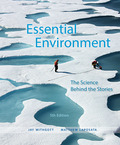
To explain: The way the population growth will be affected by numbers if all the other values are equal.
Answer to Problem 3CEF
If all the values are equal, then the population growth will increase due to the increase in the demand of the minerals obtained after mining. This will lead to the decrease in population of people ahead as some specific regions will be allotted for mining leading to the shifting of the population to new places.
Explanation of Solution
Mining is used for the extraction of minerals, ores and heavy metals used for a variety of purposes like utensils, coins and manufacturing of machines.
There will be a decrease in the population of the women, men and children in the region in which mining is taking place as these people will be shifted to other regions where better infrastructure and healthcare facilities will be available. The increase in the population of the people leads to the depletion of the resources and minerals. This causes an increase in the manufacturing and mining of metals and ores from the areas defined in a geographical region.
Want to see more full solutions like this?
- Subject: Hydrogeology Please answer both parts of the question correctly and in detail and show all workarrow_forwardDiscussion Question: Climate Change A+ The link below explains how scientists study past climates. After the introduction, there are 6 more links within the web page. Please go over each of the six links. Then, write one paragraph about each link explaining what you learned in your own voice. You should end up with 6 paragraphs total. http://earthobservatory.nasa.gov/Features/Paleoclimatology/paleoclimatology_intro.php Please always write in your own words and hence, your own voice. Plagiarism is completely unnecessary.arrow_forward1. List the five REASONS for seasons. Please be careful. I am not looking for INFLUENCES on seasons such as, Global Warming and winds. Think about axial parallelism, for example. (20 points). 2. Are we closest to the sun during the Northern Hemisphere summer or winter (5 points)? Is it called the aphelion or the perihelion (5 points)? 3. When does everyone receive 12 hours of day and 12 hours of night (5 points)? 4. During what Northern Hemisphere season do the penguins in Antarctica (the Southern Hemisphere) receive 24 hours of darkness (5 points)? 5. The water molecule is polar with two offset hydrogen atoms bonded to one oxygen atom. What are two characteristics or properties of the water molecule due to its polarity (10 points)? 6. The dew point temperature is 68 degrees Fahrenheit. Relative humidity is at 50%. Saturation vapor pressure is 24 millibars. What is the actual vapor pressure in the air in units of millibars? It is not a trick question. Look in the textbook under…arrow_forward
- Discussion Question: Ecosystems Essentials A+ of 1000 Exof-spil OCEAN The Human Denominator Assignment As we learn about how the earth works, we learn to identify the different earth spheres and how they overlap and affect one another. An understanding of the Earth's systems and spheres takes practice. More importantly, we can see the "Domino Effect" of the spheres as they interact with one another. We have learned that while endogenic processes are separate from exogenic process, the lithosphere affects the atmosphere which affects the hydrosphere, and the biosphere. Now, we can reverse the situation and consider how the biosphere, you and I, affectarrow_forwardGo to the following link. https://climate.nasa.gov/evidence/ Read over all of the links about the Climate Evidence, Causes, and Effects. Then, write a 15-20 sentences about what you learned.arrow_forwardPart C. Can someone draw and explain the steps to help with my understanding.arrow_forward
 Applications and Investigations in Earth Science ...Earth ScienceISBN:9780134746241Author:Edward J. Tarbuck, Frederick K. Lutgens, Dennis G. TasaPublisher:PEARSON
Applications and Investigations in Earth Science ...Earth ScienceISBN:9780134746241Author:Edward J. Tarbuck, Frederick K. Lutgens, Dennis G. TasaPublisher:PEARSON Exercises for Weather & Climate (9th Edition)Earth ScienceISBN:9780134041360Author:Greg CarbonePublisher:PEARSON
Exercises for Weather & Climate (9th Edition)Earth ScienceISBN:9780134041360Author:Greg CarbonePublisher:PEARSON Environmental ScienceEarth ScienceISBN:9781260153125Author:William P Cunningham Prof., Mary Ann Cunningham ProfessorPublisher:McGraw-Hill Education
Environmental ScienceEarth ScienceISBN:9781260153125Author:William P Cunningham Prof., Mary Ann Cunningham ProfessorPublisher:McGraw-Hill Education Earth Science (15th Edition)Earth ScienceISBN:9780134543536Author:Edward J. Tarbuck, Frederick K. Lutgens, Dennis G. TasaPublisher:PEARSON
Earth Science (15th Edition)Earth ScienceISBN:9780134543536Author:Edward J. Tarbuck, Frederick K. Lutgens, Dennis G. TasaPublisher:PEARSON Environmental Science (MindTap Course List)Earth ScienceISBN:9781337569613Author:G. Tyler Miller, Scott SpoolmanPublisher:Cengage Learning
Environmental Science (MindTap Course List)Earth ScienceISBN:9781337569613Author:G. Tyler Miller, Scott SpoolmanPublisher:Cengage Learning Physical GeologyEarth ScienceISBN:9781259916823Author:Plummer, Charles C., CARLSON, Diane H., Hammersley, LisaPublisher:Mcgraw-hill Education,
Physical GeologyEarth ScienceISBN:9781259916823Author:Plummer, Charles C., CARLSON, Diane H., Hammersley, LisaPublisher:Mcgraw-hill Education,





